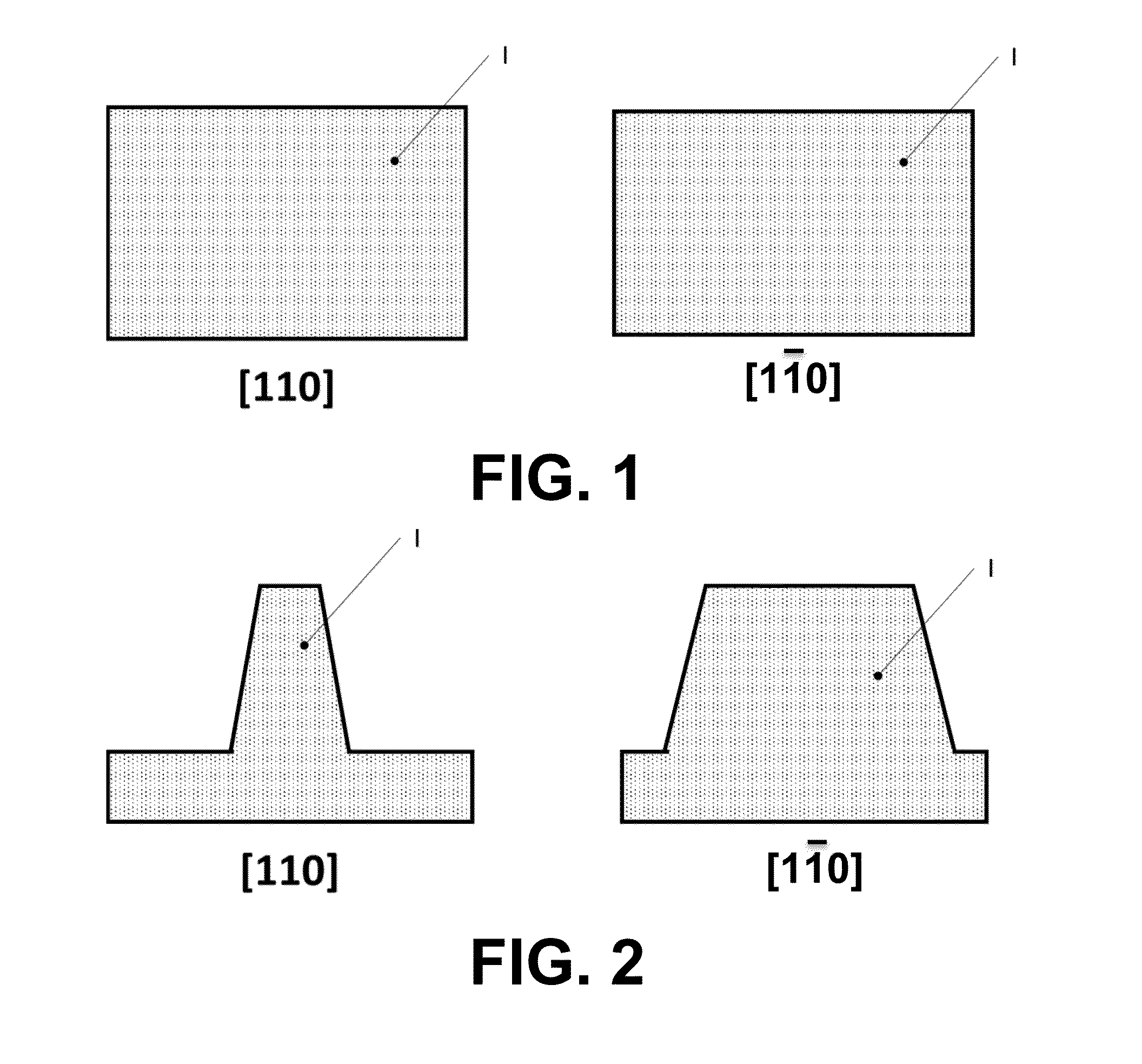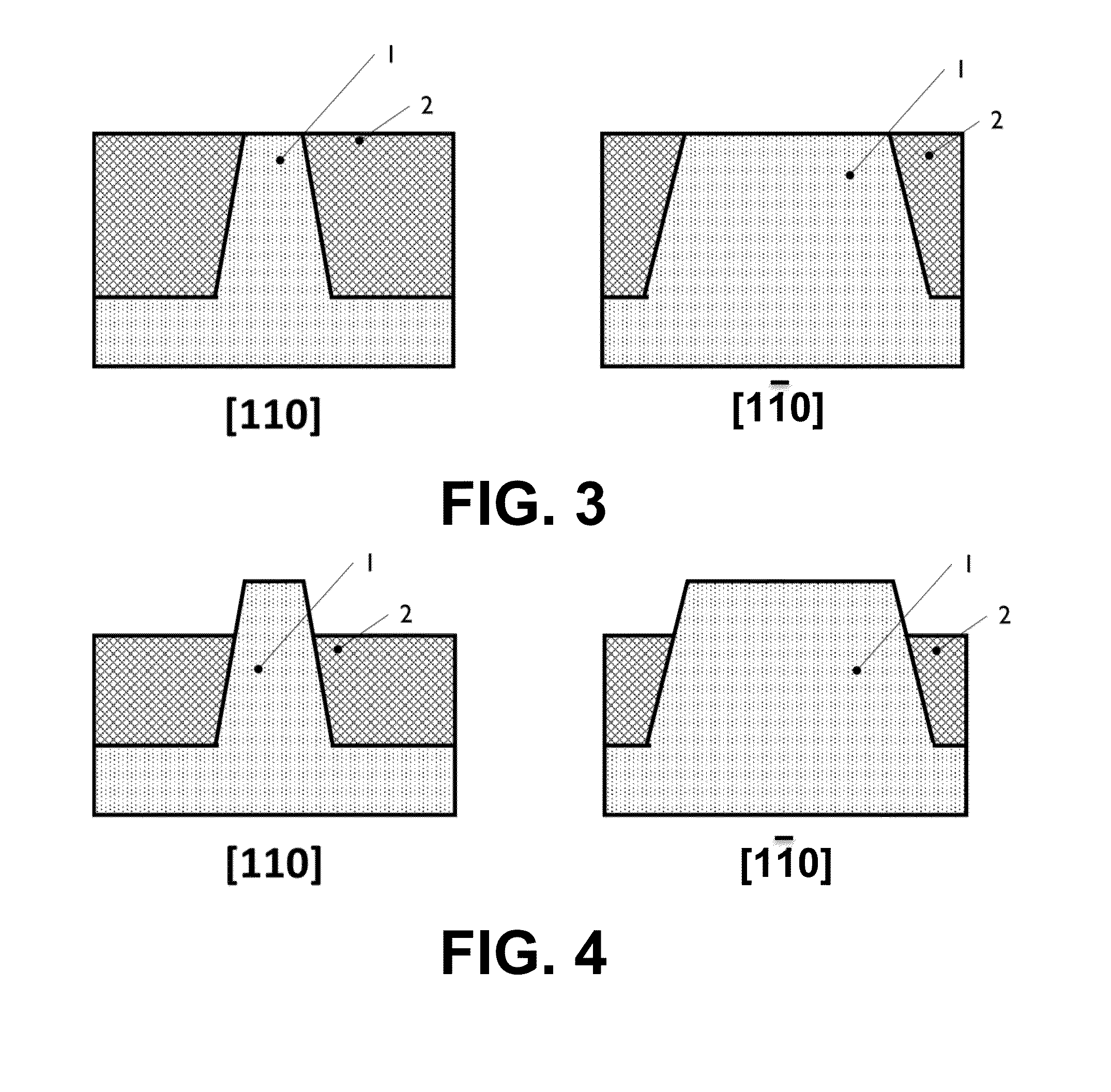Method for Reducing Contact Resistance in MOS
- Summary
- Abstract
- Description
- Claims
- Application Information
AI Technical Summary
Benefits of technology
Problems solved by technology
Method used
Image
Examples
example 1
Manufacture of a Si Fin Comprising an Area on which a InAs Source (or Drain) Structure Will be Grown
[0076]FIG. 1 shows the silicon substrate (1) before formation of the fin. The left side of FIG. 1 shows a cross-section of the substrate (1) perpendicular to the [110] direction. The right side of FIG. 1 shows a cross-section of the substrate (1) perpendicular to the [110] direction which is itself perpendicular to the [110] direction. In the following, the cross-section of the substrate perpendicular to the [110] direction will be referred to as the front cross-sectional view while the cross-section of the substrate perpendicular to the [110] direction will be referred to as the side cross-sectional view.
[0077]FIG. 2 shows the fin obtained after an etching process operated on the silicon substrate (1). Both cross-sections are cutting in half the area of the substrate where the InAs structure will be grown.
[0078]FIG. 3 shows the formation of a shallow trench isolation (STI) by filling...
example 2
Growing of a InAs Source (or Drain) Structure on the Structure of Example 1
[0081]The sample of Example 1 was placed in a MOVPE (MetalOrganic Vapor Phase Epitaxy) reactor.
[0082]Referring now to FIG. 6, prior to the InAs selective area growth, the surface of the fin was thermally cleaned from its native oxide by heating it up to a temperature of 850° C. under a H2 atmosphere at a pressure of less than 100 mbar for a period of from 5 to 10 min. If the substrate is made of Ge instead of Si, the backing should be performed above 500° C. For an intermediate composition of the substrate (SinGe1-n), an intermediate temperature is suitable and can be easily determined by trial and errors.
[0083]Following this bake step, the temperature was kept at the same bake temperature with pressure between 50 mbar and 500 mbar during 15 min to expose the Si surface to tertiarybutylarsine in order to promote the interdiffusion of As into a top portion of the Si fin. Alternatively, AsH3 could also have bee...
example 3
Growing of a InAs Layer on a Pre-Formed Source (or Drain) Structure
[0086]By a process analog to the one described in Example 2, an InAs (or other III-V) layer can be grown on top of a pre-formed SinGe1-n source or drain. For this purpose, the same process of Example 2 can be repeated except that it starts by cleaning the surface of the pre-formed SinGe1-n source or drain instead of cleaning the fin. It then proceeds by exposing the source or drain surface to an As precursor, exposing the source or drain at a lower temperature to tertiarybutylarsine and trimethylindium until a thickness of InAs of about 5-10 nm is obtained, and growing a layer of InAs at a higher temperature until the desired height is obtained. In this case, InAs is used to reduce the contact resistance of the pre-existing source / drain.
PUM
 Login to View More
Login to View More Abstract
Description
Claims
Application Information
 Login to View More
Login to View More - R&D
- Intellectual Property
- Life Sciences
- Materials
- Tech Scout
- Unparalleled Data Quality
- Higher Quality Content
- 60% Fewer Hallucinations
Browse by: Latest US Patents, China's latest patents, Technical Efficacy Thesaurus, Application Domain, Technology Topic, Popular Technical Reports.
© 2025 PatSnap. All rights reserved.Legal|Privacy policy|Modern Slavery Act Transparency Statement|Sitemap|About US| Contact US: help@patsnap.com



